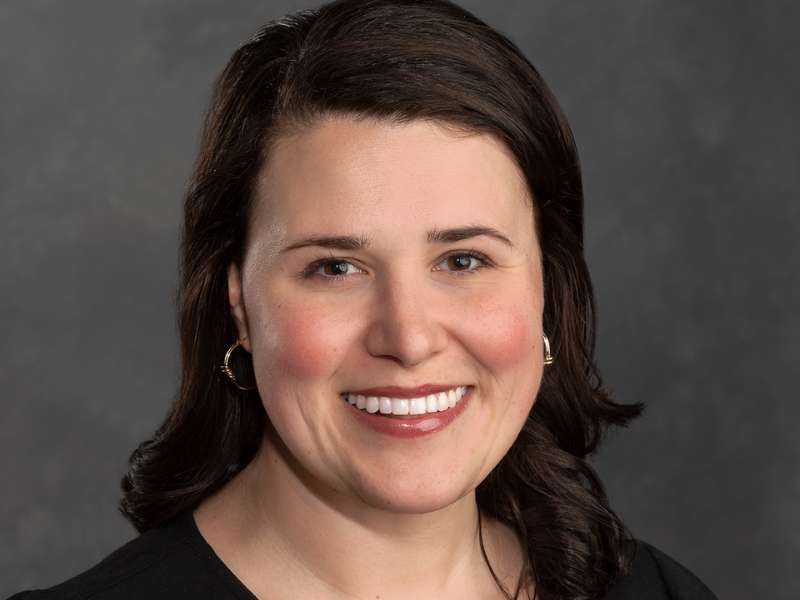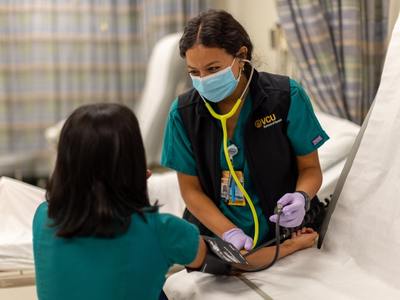Simulation and student success: Q&A with director of the Clinical Learning Center
September 19, 2024

Stop by the Clinical Learning Center (CLC) in the VCU School of Nursing, and you’ll find students immersed in hands-on practice, refining skills, and navigating simulated scenarios that prepare them for real-world clinical challenges. In honor of Healthcare Simulation Week, we sat down with the school’s leader driving simulation education, Clinical Learning Center (CLC) director Meredith Deegan.
Can you tell us about your journey into the field of nursing education and simulation?
Extensive travel and international living experiences prior to beginning my career in nursing gave me opportunities to experience different healthcare systems and delivery in multiple countries.
Traveling to over 20 countries including Latin America, South America, Asia, Africa, and Europe during my childhood and teenage years provided me with the opportunity to learn about different cultures, customs, and perspectives. Travel to remote and urban locales to work on public health projects and initiatives throughout college gave me insight and experience of foreign languages and cultures, leadership and communication skills, and knowledge of public health systems in the United States and abroad.
My journey in healthcare has been characterized by lots of twists and turns. These experiences have led me to where I am today and I believe that they help inform my nursing practice, expand my worldview, make me more empathetic, and allow me to connect with learners from many different backgrounds.
The most exciting things about simulation for me are the active learning environment and the joy that students have being able to practice in a safe space; learning new skills that will help them be successful with real live patients; the innovation in simulation teaching and learning strategies and the ability to recreate real-life scenarios for the student; working with and mentoring faculty to help them grow as educators and learn new teaching strategies; and new ways that you can simulate different patient presentations.
Meredith Deegan
Director, Clinical Learning Center
Tell us about your background and how it prepared you for your current work in the Clinical Learning Center?
After getting my undergraduate degree in Spanish and healthcare studies at the University of Richmond, I continued to pursue public health through the role of an infectious disease epidemiologist at the Virginia Department of Health prior to pursuing a career in nursing. At the Richmond City Health Department, I gained experience in communicable disease prevention, care management, public health, and epidemiology. In addition to addressing infectious disease outbreaks and management at a city level, I utilized my bilingual ability and worked with Spanish-speaking populations on different community health initiatives. This opportunity allowed me to develop important skills in cross-cultural care, supervision and leadership of teams and programs, and collaboration with stakeholders and community partners. I feel like I continue to bring this passion for health equity, sense of service to others, and perspective of different cultures, languages, backgrounds to my current role.
I attended the University of Virginia Master’s of Nursing Clinical Nurse Leader (CNL) program before working directly in patient care as a cardiac nurse and ambulatory care nurse in multiple specialties. This program was rigorous in its preparation of students to become nurses and leaders in the clinical setting. The CNL certification focuses on quality improvement across the continuum of care. This certification has led me to pursue multiple quality improvement projects, to collaborate with interdisciplinary teams, and to advocate for improvements in patient care, safety, and satisfaction in my roles in nursing. I use these skills to continue to implement evidence-based practices in the simulation setting.
Although I loved working directly with patients, I never lost my desire to have a positive impact on the healthcare system. Through my work, I saw time and time again the opportunity and need for nurses to have a seat at the table as leaders, skilled clinicians, and providers working directly with the patient. I began working as an educator for HCA in the Capital Division, covering education for several units as a nurse educator. This role involved working with novice to expert nurses on everything from orientation to professional development and continuing education. In this role, I began to see the impact of immersive simulation activities for the learner, whether they had one year or many years of experience. We typically focused on high risk, low frequency events in the acute care setting/hospital setting for designing simulations.
My main focus was ST-elevated myocardial infarction (STEMI) drills to prepare clinicians to help a patient having a heart attack get to the catheterization lab as soon as possible to stop the damage to their heart from the heart attack. We also did many mock code events. Our objective was to validate clinician competency with skills. It was not uncommon to see what discharges were happening in the hospital and then in between patients, to take over the room, and run simulations to provide just-in-time training on the fly.

I loved this work and it has prepared me for my role as director of the CLC because it made me be adaptable to the needs of the learner, creative in meeting objectives and coming up with simulation scenarios on-the-fly, resourceful in using materials in whatever setting we were in, and organized to be able to put on an event for various groups of learners as requested with little preparation time. In my opinion, simulation (and education) roles make you resourceful and a jill-of-all-trades: one day you may be creating simulated medications to practice drug calculation and medication administration, whereas other days you may be changing out mannequin lungs and going back to the user manual to troubleshoot technical problems to make sure your learner can complete a skill for CPR certification.
What are some of the key responsibilities and challenges you face in your role?
As the director of the CLC, I am responsible for guiding the goals and initiatives within the CLC in alignment with the School of Nursing strategic plan, maintaining oversight and accountability for CLC operations and budget, and serving as an advocate and mentor for other faculty in simulation, among other things. Some of the challenges that I face in overseeing healthcare simulation-based education is ensuring that we provide the best active learning experience to help our students advance their critical thinking and problem-solving skills to help them be the best nurses or nurse practitioners for their patients.
The ultimate goal is the delivery of excellent care for the patient. So, when I look at how do we design and facilitate simulations, I want to make sure that we are creating experiences that will further a student’s ability to become a critical thinker and compassionate caregiver, and give them a strong foundational of technical and psychomotor skills that they will need to be a successful clinician.
A challenge is also staying abreast of the changing innovative teaching-learning strategies and making sure that we are meeting the learner where they are- we are constantly evaluating our programming to see how we can better engage the learner through things like gamification strategies, escape rooms, immersive activities, and virtual reality.
What is most exciting to you about working at the Clinical Learning Center?
The most exciting things about simulation for me are the active learning environment and the joy that students have being able to practice in a safe space; learning new skills that will help them be successful with real live patients; the innovation in simulation teaching and learning strategies and the ability to recreate real-life scenarios for the student; working with and mentoring faculty to help them grow as educators and learn new teaching strategies; and new ways that you can simulate different patient presentations.
To those not familiar, what do the simulation suites look and feel like?
We have two high-fidelity immersive simulation rooms at the School of Nursing that are set up with everything you would find in a hospital room (hospital bed, a manikin, headwall with suction, oxygen, medical air, Pyxis automated medication dispensing machine, code cart, tray table, etc.) as well as four classroom spaces that we can convert into immersive simulation rooms.
What are some of the most innovative technologies or techniques in the CLC? How do these additions improve learning outcomes?
An innovative technology we use in the CLC is video recording through Echo360 video. This allows the students to record skills or simulation activities in real-time and review them during iterative practice or submit them for grades.
In my opinion, simulation (and education) roles make you resourceful and a jill-of-all-trades: one day you may be creating simulated medications to practice drug calculation and medication administration, whereas other days you may be changing out mannequin lungs and going back to the user manual to troubleshoot technical problems to make sure your learner can complete a skill for CPR certification.
How does the CLC collaborate with other departments or disciplines within VCU and possibly with external partners to enhance simulation-based learning experiences?
I like to say that the CLC is the heart of the School of Nursing. It is an area where we see students across all programs, both undergraduate and graduate. We interact with faculty and staff across the School of Nursing as well.
We collaborate with course lead faculty to design simulations to meet the clinical objectives of their course, but also to make sure the simulation itself meets the design standards of national and international standards from our credentialing bodies: Society for Simulation in Healthcare and the International Nursing Association of Clinical Simulation and Learning. We also work closely with our IT department staff, Online Learning and Teaching Support Instructional Designers, and other units at the school of nursing on any simulation or active learning requests.
Recently, we have been collaborating more with other VCU schools that have simulation centers as well, such as the School of Medicine and the College of Health Professions to share best practices and simulation ideas.
What advice would you give to nursing students who are about to engage in their first simulation experience? What about nurse educators or coordinators using simulation set-ups as part of their practical and technical curriculum?
Simulation is a great learning modality for nursing students because it really puts them in the position to think like a nurse, dealing with competing priorities and time pressure, but also in a safe space where they can make mistakes without consequences.
Frequently we might see education as something the faculty administers and the students receive, but in simulation students can be an active participant in their education and we can tailor situations to skills or critical thinking exercises they may need to grow in their practice as a clinician and care provider.
Also, simulation is really fun! It is great to be in a field where you can be creative and find joy in day-to-day work. Like healthcare, simulation and the needs of students are constantly changing and to be successful, you have to be willing to continue to learn, to ask for help, to collaborate, to be resourceful, and to engage with material across many different disciplines. It is busy and hard at times to keep up with all of the new developments, technologies, and innovations, but I feel that I am making a difference in the future of healthcare by having a direct impact on nursing students and their education during their formative time at VCU School of Nursing.